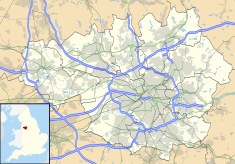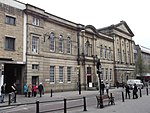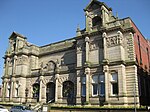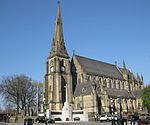|
Derby Hall, Bury
The Derby Hall is a Victorian neo-classical building situated on Market Street in the centre of Bury, Greater Manchester, England. It is a Grade II listed building.[1] HistoryThe Derby Hall was built in the late 1840s at the instigation of Edward Smith-Stanley, 13th Earl of Derby.[2] It was designed by Sydney Smirke, an architect best known today for his work on the circular reading room at the British Museum.[3] The building has a central Venetian window and a pedimented portico with four attached columns.[4] It was originally the central part of a larger development that included the Derby Hotel on the left, and the Athenaeum on the right (both also designed by Smirke). These other two buildings were demolished in 1965[2] and 1971, respectively.[5] Construction of the building began at Christmas 1848 and was completed in October 1850.[6] The hall was opened on 6 November 1850 with a concert which was attended by 600 people.[7] The building was originally known as the Public Rooms, although it quickly became known as the Town Hall. At its opening, it contained a magistrate's court, a police station, the Earl of Derby's estate offices and a large assembly room.[2] Stanley hoped the building would become the meeting place for Bury's council; however, owing to a disagreement between the earl and the local authority, it was not initially used for that purpose.[2] After the First World War the council acquired the building from the Stanley family and used it as a council building.[8] The council moved to the new Town Hall on Knowsley Street in 1954[9] and, since 1979, the building has been operated by a registered charity called Bury Metropolitan Arts Association, which uses it as a theatre and concert venue known as The Met.[10][11] One notable concert held in the building was by rock band Joy Division on 8 April 1980, which descended into a riot after some of the audience started throwing bottles at the stage. This was because Alan Hempstall of Crispy Ambulance and Simon Topping of A Certain Ratio filled in on vocals, since Joy Division's own lead singer Ian Curtis was recovering from an attempted suicide attempt the previous day.[12] See alsoReferences
|
||||||||||||||||||||||||
Portal di Ensiklopedia Dunia




